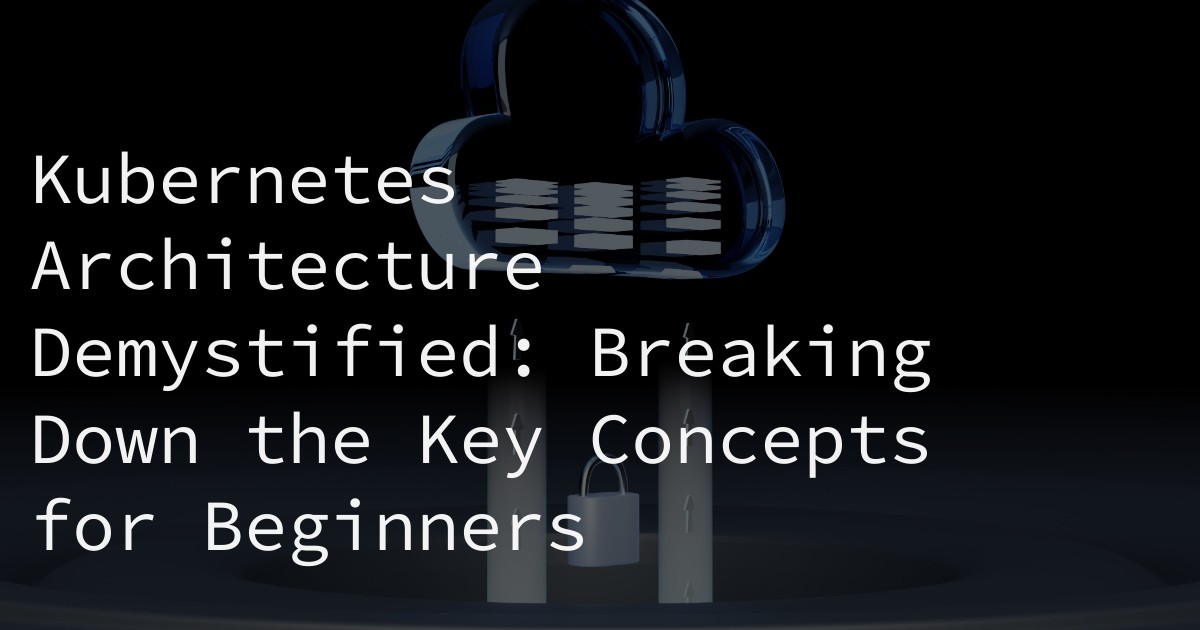
23 Oct Kubernetes Architecture Demystified: Breaking Down the Key Concepts for Beginners
Kubernetes is a powerful open-source platform for automating deployment, scaling, and management of containerized applications. As more and more organizations adopt Kubernetes for their container orchestration needs, it is essential to have a thorough understanding of its architecture. In this article, we will demystify the key concepts of Kubernetes architecture and provide tips for beginners to design and implement their own Kubernetes architecture.
Introduction to Kubernetes Architecture
Kubernetes architecture is based on a master-slave model, where the master node manages and controls the worker nodes. The master node is responsible for maintaining the desired state of the cluster, while the worker nodes run the actual applications. This architecture allows for efficient management and scaling of containerized applications.
Key Concepts of Kubernetes Architecture
Before diving into the components of Kubernetes architecture, it is essential to understand the key concepts that form the foundation of this platform. These concepts include:
- Master and Worker Nodes
- Pods
- Services
- ReplicaSets
- Deployments
- Namespaces
Each of these concepts plays a crucial role in the functioning of Kubernetes architecture and will be discussed in detail in the following sections.
Understanding Kubernetes Components and Their Functions
Master Node
The master node is the control plane of the Kubernetes cluster and is responsible for managing and coordinating all the activities within the cluster. It consists of several components, including:
- API Server: The API server acts as the gateway for all communication within the cluster.
- Scheduler: The scheduler assigns workloads to the worker nodes based on resource availability and constraints.
- Controller Manager: The controller manager is responsible for maintaining the desired state of the cluster by monitoring and responding to changes.
- etcd: etcd is a distributed key-value store that stores the cluster’s configuration and state information.
Worker Nodes
The worker nodes are responsible for running the actual applications and are managed by the master node. Each worker node consists of the following components:
- Kubelet: The kubelet is responsible for managing the containers on the node and communicating with the master node.
- Container Runtime: The container runtime is responsible for running the containers on the node.
- Kube Proxy: The kube proxy is responsible for handling network communication between the nodes and the services.
ALSO READ
Other Components
In addition to the master and worker nodes, there are several other components that play a crucial role in the functioning of Kubernetes architecture. These include:
- Ingress Controller: The ingress controller manages external access to the services within the cluster.
- Persistent Volumes: Persistent volumes provide persistent storage for stateful applications.
- ConfigMaps: ConfigMaps store configuration data that can be accessed by containers within the cluster.
- Secrets: Secrets store sensitive data, such as passwords and API keys, that can be accessed by containers within the cluster.
How to Design a Basic Kubernetes Architecture
Identifying the Requirements
The first step in designing a Kubernetes architecture is to identify the requirements of your application. This includes understanding the application’s needs, resource requirements, scalability requirements, and high availability requirements.
ALSO READ
Determining Cluster Size and Configuration
Based on the requirements, you can determine the size and configuration of your cluster. This includes deciding on the number of nodes, node types, network configuration, and storage configuration.
Mapping Components to Cluster Architecture
Once you have determined the cluster size and configuration, you can map the various components of Kubernetes to your cluster architecture. This includes deciding on the placement of the master node, worker nodes, ingress controller, persistent volumes, and configmaps and secrets.
Implementing Security Measures
Security is a crucial aspect of any architecture, and Kubernetes is no exception. Some essential security measures to consider when designing your Kubernetes architecture include:
- Role-based access control (RBAC): RBAC allows you to control access to resources within the cluster.
- Network policies: Network policies allow you to control network traffic within the cluster.
- Security context: Security context allows you to set security parameters for containers within the cluster.
- Secrets management: Proper management of secrets is crucial for maintaining the security of your cluster.
Tips for Beginners in Kubernetes Architecture
For beginners, designing and implementing a Kubernetes architecture can be a daunting task. Here are some tips to help you get started:
- Start small and grow gradually: It is best to start with a small cluster and gradually add more nodes as needed.
- Take advantage of resources and support: There are many resources available, such as documentation, tutorials, and community support, to help you learn and troubleshoot any issues.
- Continuously monitor and optimize your architecture: Regularly monitoring and optimizing your architecture will help ensure its efficiency and stability.
- Stay up-to-date with new releases and features: Kubernetes is continuously evolving, so it is essential to stay updated with new releases and features.
- Learn from others’ experiences and best practices: There is a wealth of knowledge and best practices available from experienced users that can help you avoid common pitfalls.
Conclusion
In conclusion, understanding the key concepts and components of Kubernetes architecture is essential for designing and implementing a successful cluster. By following the tips for beginners and continuously monitoring and optimizing your architecture, you can ensure the efficiency, scalability, and security of your Kubernetes environment.
RELATED ARTICLES:



Sorry, the comment form is closed at this time.